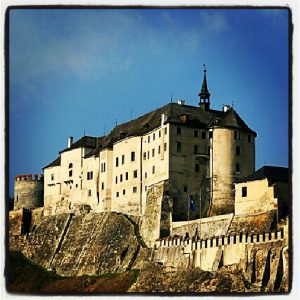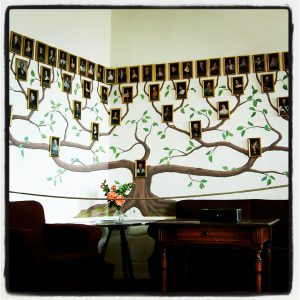Cesky Sternberk Castle: The star of the Posazavi region
By Tracy A. Burns
 Perched on a hill overlooking the Sazava River, Cesky Sternberk Castle dominates the Posazavi region with its imposing, massive Gothic exterior. Inside, there is an eclectic collection of treasures from Renaissance chests to Rococo furniture to be viewed on the 50-minute tour. The Sternberg family’s eight-pointed star is prominent throughout the 15 representative rooms. It takes a little over an hour to get there from Prague.
Perched on a hill overlooking the Sazava River, Cesky Sternberk Castle dominates the Posazavi region with its imposing, massive Gothic exterior. Inside, there is an eclectic collection of treasures from Renaissance chests to Rococo furniture to be viewed on the 50-minute tour. The Sternberg family’s eight-pointed star is prominent throughout the 15 representative rooms. It takes a little over an hour to get there from Prague.
The founding of Cesky Sternberk Castle
The story of Cesky Sternberk began sometime before 1242 when Zdeslav of Divisov had a castle built on this site. At that time there were many German settlers in the region, and he took the name Sternberk from the German word for star (stern) and the German word for hill (berk). The eight-pointed star is still the Sternberg symbol today.
Fighting against King George of Podebrady
During the Hussite wars of the 15th century, the Catholics opposed the Hussite Czech King George (Jiri) of Podebrady, who led the Utraquists. Their main belief was that worshippers should be given both bread and wine during Eucharist. The owner of the castle during this period, Petr of Sternberg, was a strong supporter of the Catholics. Luckily, no battles took place at the castle during these years of pillaging and destruction in Bohemia. However, Zdenek Konopistsky of Sternberg did do battle with his relative George of Podebrady in 1465. Zdenek was one of the leaders of the Zelenohorska unit that challenged the king and the Utraquists. Zdenek did not fare well, unfortunately, and the castle was destroyed by George of Podebrady’s army. George of Podebrady would be the only leader to conquer Cesky Sternberk.
From the 15th century to the late 20th century
The castle saw happier times when it was reconstructed in the 15th and 16th centuries. The tower erected in 1480 still stands today. During the Thirty Years’ War Cesky Sternberk faced attacks from the Swedes and experienced famine, but soon after the conflict Baroque reconstruction occurred. When the Holic of Sternberg family died out in 1712, the clan would not have possession of Cesky Sternberk Castle again until 1841. In the early 20th century there were more renovations. Then, in 1949, the Communists took the castle away from Jiri Sternberg. Still, under totalitarian rule, Jiri and his family were allowed to live in two rooms in the castle under strict conditions. Jiri even gave tours of Cesky Sternberk during the Communist years. Finally, in 1992, the current owner, Zdenek Sternberg, got the property back in restitution.
The Knights’ Hall
 The first room visited on the tour is the most lavish. The Knights’ Hall dates from around 1500 and features ornate 17th-century stucco adornment on the high walls and ceiling. Coats-of-arms relating to the family decorate the walls, too, including one symbolizing the wedding of George of Podebrady to Kunhata of Sternberg. The portraits on the walls depict generals from the Thirty Years’ War with one exception: Clad in knights’ armor, George of Podebrady makes an appearance here. Massive black Renaissance chests are on display. Two 250-kilo Czech crystal chandeliers enthrall with their 500 glass cut decorations. Two sets of leather chairs from different time periods are positioned next to each other. The chairs from the early 20th century are low and look comfortable. The other chairs, hailing from Gothic or Renaissance times, are rigid with high backs and rich engraving on the armrests. A 17th-century Florentine cabinet is inlaid with semiprecious stones and marbles. Make sure you look down – the floor is decorated with the eight-pointed Sternberg star.
The first room visited on the tour is the most lavish. The Knights’ Hall dates from around 1500 and features ornate 17th-century stucco adornment on the high walls and ceiling. Coats-of-arms relating to the family decorate the walls, too, including one symbolizing the wedding of George of Podebrady to Kunhata of Sternberg. The portraits on the walls depict generals from the Thirty Years’ War with one exception: Clad in knights’ armor, George of Podebrady makes an appearance here. Massive black Renaissance chests are on display. Two 250-kilo Czech crystal chandeliers enthrall with their 500 glass cut decorations. Two sets of leather chairs from different time periods are positioned next to each other. The chairs from the early 20th century are low and look comfortable. The other chairs, hailing from Gothic or Renaissance times, are rigid with high backs and rich engraving on the armrests. A 17th-century Florentine cabinet is inlaid with semiprecious stones and marbles. Make sure you look down – the floor is decorated with the eight-pointed Sternberg star.
The Dining Room
The Dining Room is the second largest space of the castle’s representative rooms. Portraits of Sternbergs dominate one wall while four Baroque paintings with scenes from the Old Testament adorn the other. In a painting featuring the Three Kings adoring Jesus, a Bethlehem star stands out in the dark sky. Look closely. The star is eight-pointed, the Sternberg variety. The painting was commissioned especially for the Sternbergs.
The Yellow Salon and the Ladies’ Lounge
The Yellow Salon stands out for its Empire-style wall painting of idyllic, country scenes. The ceiling features rich stucco decoration from the 1760s. Stunning Baroque frescoes are found on the ceiling of the Ladies’ Lounge. The 18th-century floral furniture is Rococo. The chairs do not have armrests because the women sitting in them during that period wore such big and wide dresses. A ladies’ writing desk, dating from the second Rococo period, is adorned with carved ivory.
The chapel and library
The chapel is dedicated to Saint Sebastian. Above the altar painting featuring The Passion of Saint Sebastian is the Hebrew inscription “Jahve,” which translates as “The Lord.” The library holds about 2,500 books, including some contemporary editions. While most volumes hail from the 19th century, two books about the history of the Sternberg dynasty date from 1689 and 1732. In the center of the room, a painting that allegedly depicts Apostle Peter is displayed, though the saint has no attributes. The man with the fluffy beard and somewhat surprised look on his face was probably painted by renowned Baroque artist Petr Brandl.
Dutch Baroque and impressive engravings
Another room entices with its Dutch Baroque furniture that features a floral motif. Check out the grandfather clock. Engravings portray scenes from the Thirty Years’ War and are just a sample of Sternberg’s collection of 545 renditions depicting the history of the 17th-century battles. One of them shows a panorama of Prague from the early 17th century when the Charles Bridge was the only bridge in town.
More rooms to see
Furniture featuring mother-of-pearl and ivory hails from the 18th century in the Oriental Antechamber. Another space is dedicated to Kaspar Maria Sternberg, who founded Prague’s National Museum. The big Baroque closet in a bedroom is decorated with spiral columns and could hold only one or two wide Baroque dresses. Almost 200 hunting trophies decorate the Hunting Lounge.
The last space
In the hallway where the tour ends, there are three impressive paintings of battle scenes. One shows the Battle of Hradec Kralove (better known internationally as Koeniggraetz), a town in eastern Bohemia where the Austrians lost to the Prussians in 1866. The painter, Filip Sternberg was a pupil of the famous Art Nouveau artist Alphonse Mucha. Filip depicts himself as a gray-haired man without a helmet in the painting. In reality, Filip had been only 14 years old when the deciding battle took place.
Other sights in the Posazavi region
Although Cesky Sternberk is the main attraction of the Posazavi region, there are many other sights worth visiting. It is possible to navigate a boat or raft through the rapids. Hiking, cycling, and horseback riding are a few of the sports the region offers. The Baroque Jemniste Chateau and Konopiste Chateau, where Archduke Franz Ferdinand lived, are nearby, too. Or take a balloon up to 500 meters in the air. In the town of Benesov, there are historical churches and intriguing museums as well as monastery ruins and a Jewish cemetery. Beer lovers can visit the Ferdinand brewery in Benesov. Other surrounding towns have impressive monuments, too.



